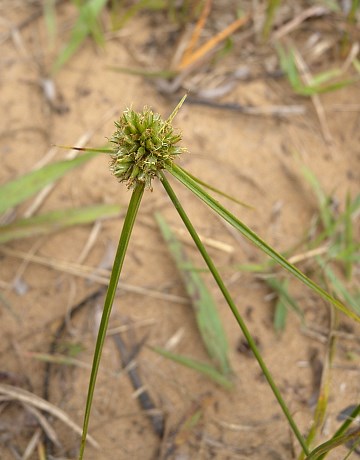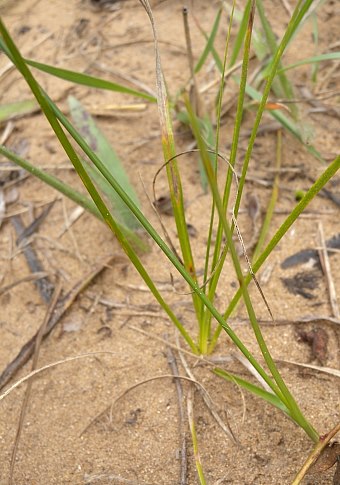Description: This perennial sedge is ½–1¼' tall, producing an unbranched flowering culm with alternate leaves. The central culm is light to medium green, slender, 3-angled, and glabrous. The alternate leaves are located along the lower one-fourth of the stem. The leaf blades are up to 8" long and 1/8" (3 mm.) across; they are light green, longitudinally grooved, glabrous, and ascending to widely spreading.

The central culm
terminates in 1-3 globoid floral spikes (usually only one spike); each
spike spans about ½" across. The first spike is always sessile; it has
1-5 ascending to widely spreading leafy bracts underneath it.
Additional spikes, if present, are found on top of ascending to
spreading stalks (rays); these stalks are ½–2" long, light green, and
glabrous. The leafy bracts are up to 6" long and 1/8" (3 mm.) across;
they vary considerably in length and resemble the leaf blades.
Individual spikes consist of a sessile cluster of many spikelets. The
secondary stalk (rachilla) of each spikelet has 3-7 floral scales on
opposite sides; these scales are
overlapping, but their outer margins
are not tightly appressed. Each scale is 2.0–2.5 mm. long and
longitudinally folded around
its floret. Each floret has a pistil with a tripartite style and 3
stamens. The blooming period occurs during the summer and fall. The
florets are wind-pollinated. The achenes are about 1.5 mm. long and
about one-half as much across; they are oblongoid, somewhat flattened,
hairless, and dark-colored. To some extent, they are blown about by the
wind. The root system consists of hard corm-like rhizomes and fibrous
roots. Vegetative offsets can be produced from the rhizomes.
Cultivation:
The preference is full or partial sun, dry-mesic to dry conditions, and
sandy soil. An acidic rocky soil (derived from sandstone, chert, etc.)
is also tolerated. This small sedge is not tolerant of much competition
from other types of ground vegetation.
Range & Habitat:
Slender Sand Sedge is occasional to locally common in sandy areas of
central and northern Illinois, while it is rare or absent elsewhere.
This sedge is native to the state.
Habitats include upland sand prairies, sandy hill prairies, stabilized
sand dunes, openings in sandy woodlands, sandy savannas, sandstone
glades and sandstone cliffs (in southern Illinois), sandy paths, sandy
fields, and sandy areas along railroads. This sedge benefits from
occasional disturbance.
Faunal Associations:
Very little is known about floral-faunal relationships for upland Cyperus
spp. (Flat Sedges). The seeds and/or spikelets are eaten by
some upland gamebirds and other birds, specifically: Greater Prairie
Chicken, Wild Turkey, American Crow, and Tree Sparrow (winter). The
foliage is palatable to deer, cattle, horses, and other hoofed
mammalian herbivores, but it is not preferred as a source of food.
Photographic Location:
A sandy path at the Hooper Branch Savanna Nature Preserve in Iroquois
County, Illinois.

Comments: This is one of a small group of Cyperus spp. (Flat Sedges) that are found in upland sandy areas. Most species in this genus are found in wetlands. This subspecies of Cyperus lupulinus has a distinct appearance, making it relatively easy to identify. It has very slender leaves and usually a single globoid cluster of spikelets (less often 2 or 3 on short stalks); individual spikelets have relatively few scales (usually 3-6). The typical subspecies of Cyperus lupulinus is slightly larger in size with more globoid spikes (3-6) per plant and more floral scales per spikelet (5-20). It also has slightly longer floral scales (2.5–4.0 mm.) than ssp. macilentus. In Illinois, the typical subspecies is about as common as ssp. macilentus in most areas of the state, except southern Illinois, where it is largely absent. An older scientific name of this species is Cyperus filiculmis. Examples of other common names are Great Plains Flat Sedge and Sand Cyperus.